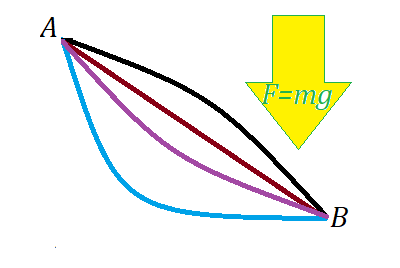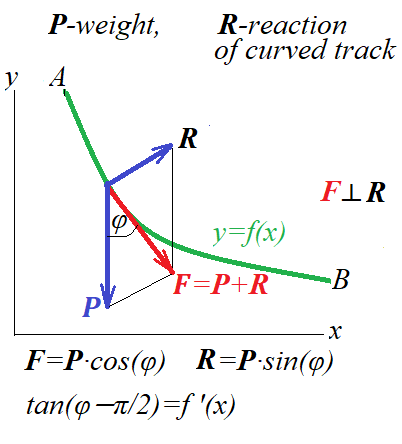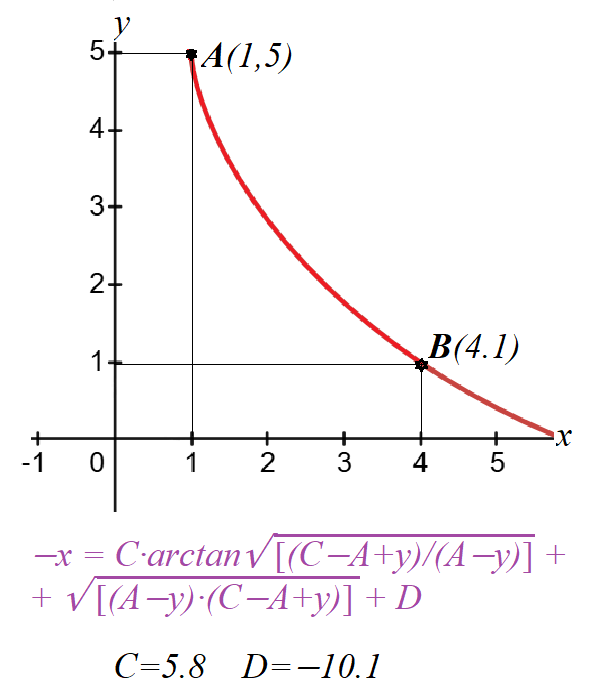Lagrangian
for N-dimensional Systems
Background
In one of the previous lectures we considered a point-mass object oscillating on a spring in an empty one-dimensional space with Cartesian coordinates (one degree of freedom).
In that case we defined a Lagrangian of an object as a difference between its kinetic and potential energies and built a theory equivalent to Newtonian but based on the Euler-Lagrange equation instead of the Newton's Second Law.
In another lecture we discussed a spring pendulum (two degrees of freedom) and used non-Cartesian parameters to define a state of a system - an angle of pendulum from a vertical and a spring's length.
It was possible but rather complicated to use the Newtonian approach, so we applied Lagrangian Mechanics to come up with the differential equations to describe a state of this system.
An important reason for using Lagrangian Mechanics with energies instead of vectors of force and accelerations in that second example was that energies are scalars, while forces and accelerations are vectors.
Manipulations with scalars are simpler, especially dealing with complex systems with more than one degree of freedom.
Obviously, no matter how we solve a problem, the calculated actual physical trajectories of objects in space must be the same.
Before proceeding any further, we strongly recommend to refresh your knowledge about conservative forces, independence of work performed by these forces from a trajectory of an object moved by them, a concept of a field and its potential.
The chapter Laws of Newton of this course is a good source of this information.
Recall that conservative forces are defined as those that depend only on position in space. Their work, performed by moving an object from one position to another, does not depend on trajectory or speed along this trajectory, but depends only on the beginning and ending positions of an object.
From the Energy Conservation Law follows that the work performed by a conservative force that moves an object changes the potential energy of this object by the amount of work performed.
Consider an isolated closed system of N point-mass objects acting on each other with conservative forces and no forces from outside of this system.
The force on the ith object is
Fi = {Fix,Fiy,Fiz}.
If this force moved this object by an infinitesimal increment
dri = {dxi,dyi,dzi},
it performed some infinitesimal amount of work
dWi = (Fi · dri) =
= Fix·dxi+Fiy·dyi+Fiz·dzi
From the Energy Conservation Law follows that potential energy of this object Ui should diminish by this amount of work
dUi = −dWi
When all N objects are moved by corresponding forces, the total increment of potential energy of an entire system is
dU = −Σi∈[1,N]dWi =
= −Σi∈[1,N](Fi · dri) =
= −Σi∈[1,N](Fix·dxi+Fiy·dyi+Fiz·dzi)
From this equation follows the relationship between an increment of a total potential energy of an entire system and each individual force
Fix = −∂U/∂xi
Fiy = −∂U/∂yi
Fiz = −∂U/∂zi
Using vectors and operator
∇i = {∂/∂xi,∂/∂yi,∂/∂zi}
above equations can be expressed as
Fi = −∇iU
for all i∈[1,N]
Lagrangian Mechanics was invented to simplify analysis of complex systems acted upon by conservative forces, like electrostatic, gravitational or spring forces.
We are going to prove that Lagrangian Mechanics of a closed (no external forces) mechanical system with its components acted among themselves with some conservative forces produces differential equations of motion that are equivalent to Newtonian equations, but easier to deal with.
Consider a system that consists of N point-masses with each ith component Ωi acted upon by conservative forces from all components within this system.
The time-dependent Cartesian coordinates of each Ωi are {xi(t),yi(t),zi(t)}, which we will denote as a vector ri(t).
Let a combined conservative force acting on component Ωi that depends on positions of all components of a system be
Fi(r1,...rN)
The Newton's Second Law of motion for each object in a system is, therefore,
Fi(r1(t),...rN(t)) = mi·r"i(t)
where each Fi is a vector of three components {Fix,Fiy,Fiz}, and each component is a function of 3N coordinates of all objects in a system,
mass mi is a mass of Ωi and
a symbol " means the second derivative of position vector ri(t) of object Ωi by time, that is, its vector of acceleration
In coordinate form the above equation can be written as
Fix(r1(t),...rN(t)) = mi·x"i(t)
Fiy(r1(t),...rN(t)) = mi·y"i(t)
Fiz(r1(t),...rN(t)) = mi·z"i(t)
In summary, we have 3N differential equations of 2-nd order, three for each component of a system of N objects.
In case of multiple objects in three-dimensional space exerting forces on each other (like all the planets of our Solar system or a nucleus with all its electrons in an atom) the vectors of forces are directed in different directions and the system of differential equations based on Newton's Second law is extremely complex.
Let's approach it differently.
Since all forces Fi are conservative, each one can be represented as
Fi(r1(t),...rN(t)) =
= −∇iU(r1(t),...rN(t))
where U(r1(t),...rN(t)) is a total potential energy of an entire system and
∇i is a vector of its partial derivatives by each coordinate of object Ωi.
∇i = {∂/∂xi,∂/∂yi,∂/∂zi}.
Let's shorten for convenience the results above as
Fi = −∇iU
and rewrite it in (x,y,z) components of Cartesian coordinates
Fix = −∂U/∂xi
Fiy = −∂U/∂yi
Fiz = −∂U/∂zi
As we see, knowing the potential energy of a system of objects is sufficient to know all the conservative forces acted on individual objects in this system.
The Newton's Second Law equation for object Ωi in vector form is
Fi(r1(t),...rN(t)) = mi·r"i(t)
which in coordinate form would be
Fix(x1(t),...zN(t)) = mi·x"i(t)
Fiy(x1(t),...zN(t)) = mi·y"i(t)
Fiz(x1(t),...zN(t)) = mi·z"i(t)
Using the potential energy, the same equations for object Ωi would be
−∂U /∂xi = mi·x"i(t)
−∂U /∂yi = mi·y"i(t)
−∂U /∂zi = mi·z"i(t)
where U=U(x1(t),...zN(t)) is a total potential energy of an entire system.
Let's address the mi·r"i(t) side of the Newton's Second Law and derive its value from the kinetic energy of an object Ωi.
We express a vector r"i(t) in (x,y,z) coordinates as
(x"i(t),y"i(t),z"i(t))
Kinetic energy of Ωi equals to Ki(t)=½mi·vi(t)² where vi is a linear speed along a trajectory
vi(t)² = r'i(t)·r'i(t) =
= x'i(t)²+y'i(t)²+z'i(t)²
Now we can express the components of an acceleration vector r"i(t) of Ωi in terms of its kinetic energy
Ki(t)=½mi·[x'i(t)²+y'i(t)²+z'i(t)²]
Partial derivatives of kinetic energy by each coordinate of velocity vector produces coordinates of an object's momentum
∂Ki /∂x'i = mi·x'i
∂Ki /∂y'i = mi·y'i
∂Ki /∂z'i = mi·z'i
Derivative by time of a momentum gives the right side of the Newton's Second Law d/dt ∂Ki /∂x'i = d/dt mi·x'i =
= mi·x"i
d/dt ∂Ki /∂y'i = d/dt mi·y'i =
= mi·y"i
d/dt ∂Ki /∂z'i = d/dt mi·z'i =
= mi·z"i
We are ready to express the Newton's Second Law in terms of kinetic and potential energy.
From
−∂U /∂xi = mi·x"i
and
d/dt ∂Ki /∂x'i = mi·x"i
follows
−∂U/∂xi = d/dt ∂Ki /∂x'i
Similarly,
−∂U /∂yi = d/dt ∂Ki /∂y'i
−∂U/∂zi = d/dt ∂Ki /∂z'i
The total kinetic energy of a system is a sum of kinetic energies of its components
K = K1+...+KN
Since each Ki depends only on a velocity of the ith object
∂Ki /∂x'i = ∂K/∂x'i
∂Ki /∂y'i = ∂K/∂y'i
∂Ki /∂z'i = ∂K/∂z'i
Using total kinetic energy of a system, the formulas describing the laws of motion of object Ωi would be
−∂U/∂xi = d/dt ∂K/∂x'i
−∂U/∂yi = d/dt ∂K/∂y'i
−∂U/∂zi = d/dt ∂K/∂z'i
Now the only participants in these equations are the total kinetic and potential energies of an entire system - just two numbers that depend on positions and velocities of system's components.
To make the theory more elegant, let's introduce a Lagrangian L=K−U that equals to a difference between kinetic and potential energy of this system.
Since kinetic energy of a system K is independent of positions of its components
−∂U/∂xi=∂(K−U)/∂xi=∂L/∂xi
and similar with partial derivatives by yi and zi.
Since potential energy of a system U is independent on velocities of its components,
∂K/∂x'i=∂(K−U)/∂x'i=∂L/∂x'i
and similar with partial derivatives by yi and zi.
Therefore, our equations look even simpler
∂L/∂xi = d/dt ∂L/∂x'i
∂L/∂yi = d/dt ∂L/∂y'i
∂L/∂zi = d/dt ∂L/∂z'i
The equations above are also differential equations of the second order, like with Newton's Second Law.
There are also 3N of these equations (three coordinates for N objects in a system).
But there is only one number, Lagrangian, also called action, a function of all positions and velocities, to deal with for all objects instead of individual forces for each object.
Lagrangian Mechanics allows to deal with complex system in a simpler way.
As the cherry on top, consider the same equations in the form
d/dt ∂L/∂x'i − ∂L/∂xi = 0
d/dt ∂L/∂y'i − ∂L/∂yi = 0
d/dt ∂L/∂z'i − ∂L/∂zi = 0
In these equations Lagrangian L depends on 3N parameters, positions and velocities of N components of our system, which are, in turn, time-dependent.
So, ultimately, Lagrangian L is a function of time.
On one hand, these are equations that define a motion of a system, that is they define a trajectory of a system changing positions and velocities of its components from one moment in time to another.
On another hand, as we discussed in the Variations chapter of this course, they produce a function of time L(t) that brings to extremum (usually, minimum) the action functional
S = ∫[t1,t2] L(t)·dt
Therefore, we can say that a mechanical system with only conservative forces present changes its state along an
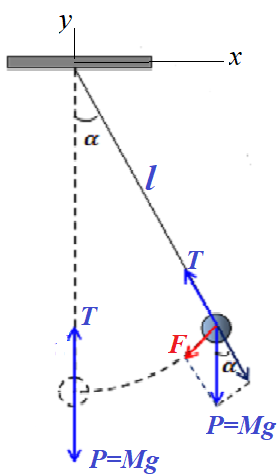
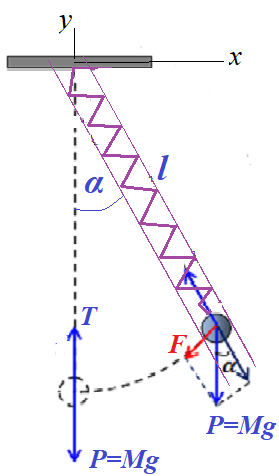 The problem of specifying the motion of an object is much more complex here because the spring tension is changing not only with an angle α(t) but also because of the movement of an object within a tube.
The problem of specifying the motion of an object is much more complex here because the spring tension is changing not only with an angle α(t) but also because of the movement of an object within a tube.
